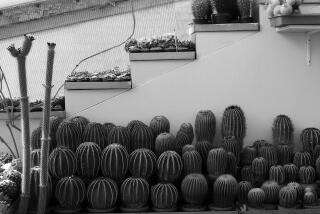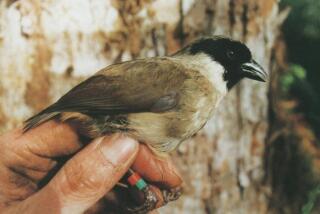Getting In Some Digs at a Few Culprits
Now that Proposition 65 (the Safe Drinking Water and Toxic Enforcement Act) has taken effect, it seems only fair that gardeners join in the spirit of the thing and start identifying plants that are a menace.
I don’t mean plants that cause rashes or other allergic reactions, or those that are poisonous, because I’m not qualified to judge on those particular problems. What I have in mind are plants that menace the garden by threatening to take it over, and end up being a whole lot of work to get rid of. This is something I know about.
As an example, one plant that should have a huge warning sign posted next to it at nurseries--similar to those popping up at gas stations and paint stores and other places that dispense potentially hazardous chemicals--is Lobelia laxiflora. I just finished trying to dig it out of my garden for the third time, but it always comes back, and I am not terribly hopeful this time around.
Deep Underground
This pretty plant with bright green, narrow-toothed leaves and red and yellow tubular flowers spreads on fat, white roots that may be as far underground as 14 inches, by my observation. When you try to dig it up, the roots break into little pieces and each piece that remains in the soil can start a new plant. So trying to eradicate it only helps propagate it, and the whole process becomes a little like a science-fiction movie as it multiplies and spreads. Should you be so foolish--as I once was--to then run a tiller through the soil in preparation for planting something else, you will soon have millions of little plants popping up.
I suppose this plant has its place, on dry slopes where little else will grow perhaps, but in my book, it should never be planted in the garden.
You can try to cage plants that grow like this. You can plant them inside a bottomless bucket or tub sunk into the soil so they can grow roots down but not out. You can surround their little piece of ground with sheet metal buried at least 14 inches deep, or you can plant them where concrete--several feet of it--surrounds them, but even then, I, for one, would never turn my back on such a plant.
Primrose and Horsetail
One menace plant that might be worth this effort was nominated for my list by a friend. It’s Oenothera berlandieri , known as the Mexican evening primrose, and has recently become quite popular because it has the prettiest of pink flowers in great abundance all summer long. But it can spread like wildfire, though I don’t consider it as difficult to dig out as the lobelia just mentioned.
Horsetails are another nomination from this friend. These most primitive of plants can spread throughout a garden and they are difficult to dig out, but they look so good near water that they might be a candidate for a cage.
Part of the problem is that we gardeners are always looking for something new to try, and we assume that if it’s being sold at nurseries, it must be OK. But nurseries seldom grow what they sell and often have no idea how something grows. One of the great battles in my garden was against a beautiful new grass I spotted at a nursery--a tall, bright silver-gray grass with only the name Elymus to identify it in the can.
Popping Up Everywhere
I still don’t know its proper name, though I have a few unprintable names of my own for it. I knew quickly that I had made a mistake when it took off in a cloud of smoke and within weeks was popping up yards away from where it was planted. Its spreading roots were deep underground and tenacious, but I think I’ve finally gotten rid of it. But to do so required laying waste to most of one bed.
Another candidate for a list of menace plants is black bamboo. I thought this prettiest of all bamboos was one of the clumping types. There are two distinct kinds of bamboo--clumping and spreading. The clumping stays in a nice if somewhat dense clump; the spreading doesn’t.
I took five years to realize my mistake this time, which is when it began to appear in distant corners of the garden. When I grabbed hold of a new sprout and pulled, up came a runner that led back to the parent. One of these runners was about 15 feet long and had traveled under the entire width of the lawn. Removing this bamboo may be this weekend’s project.
That is the real problem with these plants--they are a whole lot of work to get rid of and unless you want to live in a forest of bamboo, or a field of lobelia, you must eventually get rid of them.
A List to Avoid
The best idea is not to plant them in the first place, and with your help, perhaps we can prepare a list of plants to be avoided, or to at least think twice about--a list of hazardous plants.
While only 29 chemicals made it onto the Proposition 65 list, I’m sure gardeners can turn up a great many more plants than that, and I will accept all nominations. Mail them to (Los Angeles Times, You Section, Times-Mirror Square, Los Angeles, Calif. 90053), and I will compile them for a future column.
Obviously the worst culprits are plants that spread underground, but not all spreaders are problem plants--Shasta daisies and many perennials spread, but never get out of hand--so when you send in your list of menace plants, be sure to include incriminating documentation, such as how it spreads (don’t forget those plants that are a pest because they seed about so easily), or why it’s so hard to get rid of. This is your chance to warn others, and to get even with these plants that are more work than they’re worth.






